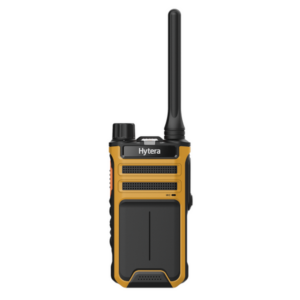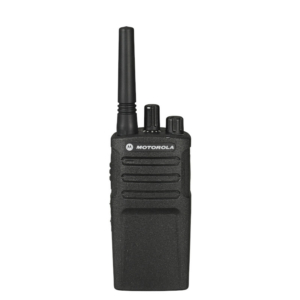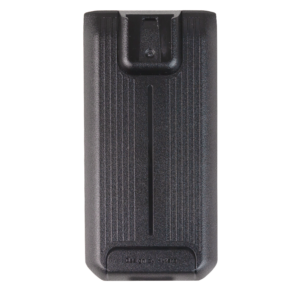While the Motorola XT420 is not a modern-day product, it still holds its own in today's PMR446 unlicensed industrial transceiver market. However, there have been several great alternatives that have appeared on the market over the years, from which we highlight the Hytera AP515LF now.

Please note the LF abbreviation, which stands for Licence Free. This is important because the AP515 transceiver of the Hytera AP series is identical in appearance to the AP515LF, but the AP515 is a professional transceiver, which needs frequency-license for usage.
Let's compare these two devices from a technical and user perspective.
External housing
The Hytera AP515LF has a water and dust resistance rating of IP54, while the Motorola XT420 has a slightly better dust and water resistance rating of IP55.
An important feature of the Hytera is its smaller size and weight, which is important for a work tool in daily use. AP515LF has a smaller battery and more advanced electronics. In terms of antenna, the Hytera is a little bigger. They are both designed for industrial usage, so you won't have to worry about falling them down a few times in a dirty, humid environment. But, as always, we are recommending using a case with the radio, which costs a small amount but will extend the life of the transceivers, so it's worth investing in a couple of harnesses or belts. Excellent harnesses and both types of devices fit comfortably in our AHCC-6700.
Battery and charging options
While the Motorola XT420 has “only” a 2100mAh battery, the Hytera AP515LF comes with an outstanding 4000mAh battery in the box. It should be noted that the Motorola XT420 comes with a dock charger as standard, which not only offers convenience but also provides a longer battery life, making it more convenient to charge the device daily. Hytera's device - on the other hand - offers a modern Type-C connector with a fast-charging function, allowing you to charge the transmitter from multiple power sources. The Type-C connection is very important because of the EU legislation. This is something Motorola will probably change in the future.
Controls and buttons
The volume control and power on the Hytera AP15LF are on separate buttons, while on the Motorola these two functions can be found on a single rotary knob. On the Hytera, volume control is done with the + and - buttons on the left side of the unit, and the power button is located at the top centre. The programmable buttons on the left side allow you to change functions. This button can be programmed using the CPS software, just like the one on the Motorola.
Connectors
The two brands use different standard connectors. Motorola uses the traditional 2 jack GP connector, while Hytera has a slightly more serious connector with several pins and a screw. We should remember, if someone wants to add Hytera AP515LF to the existing Motorola XT420 fleet, the same audio accessories cannot be used.
Audio capabilities
Motorola has nothing to be ashamed of with the sound quality of the XT420, but the Hytera AP515LF represents a higher level! The Hytera AP515LF transceiver features a 3W speaker and advanced noise cancellation algorithm that eliminates unwanted background noise, reduces distortion and suppresses noise from other devices to ensure louder, clearer sound.
Speech encryption
The speech encryption function is available in both devices. The Hytera offers us one encryption template, while the Motorola gives us a choice of 8 different encryption templates. Although, the Hytera AP515LF is easier to program.
Programming
Programming is an additional option, as the transceivers come ready to use, pre-programmed. However, it is worth thinking about which programmable functions you will need (encryption, VOX, channel extension) before ordering, as these are carried out by Anico technicians free of charge before delivery. The transceivers can also be programmed later with its own programming cable, or our technicians can do it for an extra cost.
In the case of Motorola, programming requires a docking charger, battery and a data cable. For the Hytera, only a PC-155 data cable is needed to communicate with the CPS program.
Let's see what functions can be programmed into the 2 transceivers.
Motorola XT420 CPS programmed additional features
- Lock the programming by password
- Enable or disable factory reset
- Turn on and off the LED feedback function
- Enable the cloning function
- 3 levels of internal microphone sensitivity adjustment
- External microphone sensitivity adjustment in 3 steps
- VOX and iVOX sensitivity level adjustment in 3 steps
- Turn on/off audio alerts
- Select the language of the voice menu: English, French, Spanish, Italian, Russian, German, Portuguese
- Adjust the volume of the sound menu from 1 to 10
- End of transmission sound on/off
- Keyboard sound on/off
- Activation of silent mode always or just when an external audio device is connected
- 2 programmable buttons to set functions: monitor function, start or stop scan/search function, send ring tone, switch speech encryption on/off
Programming channels: by default, we have 2 x 8 channels, containing the first 1 to 8 PMR446 frequencies. Extension of frequencies 9-16 can be requested by service.
- Change the frequency of the channel
- Change CTCSS and DCS noise lock codes, but you can also set a unique code
- S witch off the channel so that it will not be possible to transmit there
- Set RX only (receive only) transmission will not work in this case
- Include the channel in the scan list
- S witch to automatic channel scanning
- Turn on and select from 4 types of speech encryption
- Separately modify the scan lists, of which 8 are available
- Create and save custom CTCSS and DCS codes, 2x6 new codes can be saved
Hytera AP515LF CPS programmed additional features
- Customize the default settings
- You can name your transceiver
- Choose between English and Chinese voice announcements
- Lock the programming of the transceiver with a password
- Configure a programmable button with short and long presses to activate or deactivate functions: change zone, deactivate noise lock, activate speech encryption
- Monitor function on/off
- Switching the VOX function on and off, adjusting the VOX sensitivity (how sensitive the microphone of the transceiver or external microphone should be, and the VOX hold time)
- Change noise lock level: choose between 2 noise lock levels - one strong and one weak. You can change these values from 1 to 9 on a given night
- Mute function on/off
- Battery charge indicator
- Adjust the volume of the feedback sounds, or even turn them off: low battery sound, button sounds and volume can be adjusted if you don't want the user to accidentally turn the transmitter to high volume
- Turn off the LED light
- Separately switch on/off the battery saver mode and configure it in 3 steps depending on how much you want to increase the battery standby time for a particular use
Channel programming: 2 zones can be created and here you can have a combination of 16+16 channels. If required, you can even put 1 channel in a zone.
- In the channel setting, you can change the frequency of each channel between 1 and 16
- You can enable and disable CTCSS and DCS encoding, freely configurable from the list provided
- Change PTT transmission time limit
- You can activate encryption and assign the channel to a scan list (8 scan lists can be programmed, you can parameterize the operation of the list, e.g. how the transceiver should scan the list, how to stop on a given channel, whether the transceiver can transmit there, etc.)
- You can also give only receive permission to specific channels, so they cannot transmit there
| Motorola XT420 | Hytera AP515LF | |
|---|---|---|
| Power | 0.5 Watt | 0.5 Watt |
| Frequency | 446 Mhz | 446 Mhz |
| Channels |
By default, the number of channels ranges from 1 to 8. Channels 9-16 can be activated from the program at the time of purchase. |
16 channels by default but can be expanded to 32 channels in 2 zones. |
| Subchannel | CTCSS 38, DCS 181 +12pcs. unique codes | CTCSS 38 DCS 181 |
| Operating mode | only analogue | only analogue |
| Battery | 2100 mAh Li-Ion | 4000 mAh Li-polimer |
| Calling voices | 6 pcs | 0 pc |
| Voice announcement | 16 pre-recorded channel names in 10 languages, or upload your own sound file for personalised channel names | English or Chinese, uploading your own audio file is not possible |
| Dimensions | 116 x 58 x 40 mm | 105 x 55 x 29.5 mm |
| Weight | 244g | 200 g |
| Average battery life | up to 20 hours | up to 25 hours |
| IP protection | IP55 | IP54 |
| Display | no | no |
| VOX/iVOX | both | VOX only |
| Antibacterial coating | yes | no |
| Encryption | yes 4 types optional | yes 1 type |
Which transceiver is the better choice?
If you feel the Motorola brand name is synonymous with transceivers, we recommend the XT420 unlicensed transceiver. Especially if it's important to charge your device with a desktop charger. Unfortunately, the charging pad is not available separately for the Hytera AP515LF.
However, if you are about to buy a new device, you should not forget the Hytera's battery, which is almost double of the Motorola XT420. In addition, the Type-C connection and automatic noise cancellation on the Hytera AP515LF transceiver are extremely useful, and the list price is lower.
So, we recommend everyone to make their own decision!
If a high level of protection is important, consider the Hytera AP525LF, which is identical to the Hytera AP515LF transceiver, with IP66 protection.

















